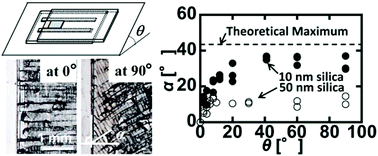Flow of condensed particles around a packing front visualized by drying colloidal suspensions on a tilted substrate†
Abstract
A gravity effect was demonstrated for 10 nm particles drying in colloidal suspensions. The particles were well-dispersed and did not sediment. However, when a suspension was dried on a tilted directional cell, a clear downward flow of particles was observed around the packing front, which was the boundary between the packed particles layer and the suspension. Three particle sizes (10–110 nm) were examined, with the most pronounced effect being on the 10 nm particles. The primary origin of the downflow was attributed to condensation of particles near the packing front and the subsequent increase in the overall density of the condensed layer. Because of the flow, the packing front was not parallel to the drying interface and tilted cracks formed in the packed layer. A mathematical model was proposed that considered conservation of the suspended particles in the condensed layer. Three competing factors of particle transport (advection, particle consumption by packing, and particle transport by the downward flow) were used to explain the experimental results. Overall, the results suggested that simple substrate tilting would be useful to evaluate whether suspended particles are easily packed or not during drying.



 Please wait while we load your content...
Please wait while we load your content...